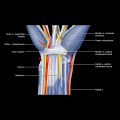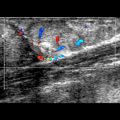Fascial Lesion
ESSENTIAL INFORMATION
Key Differential Diagnosis Issues
Helpful Clues for Common Diagnoses
 Probably caused by repetitive microtrauma ± microvascular injury
Probably caused by repetitive microtrauma ± microvascular injury
 Common in runners (10%)
Common in runners (10%)
 Affects central band attachment to medial calcaneal tuberosity
Affects central band attachment to medial calcaneal tuberosity
 Manifested as thickening of plantar fascia at calcaneal insertion
Manifested as thickening of plantar fascia at calcaneal insertion
 > 4.3-mm thickness considered abnormal
> 4.3-mm thickness considered abnormal
 ± plantar calcaneal spur
± plantar calcaneal spur
 Small foci of dystrophic calcification as well as small intrafascial tears can sometimes be seen in thickened fascia at calcaneal insertion
Small foci of dystrophic calcification as well as small intrafascial tears can sometimes be seen in thickened fascia at calcaneal insertion
 ± edema, reduced lobulation, thinning, or early fibrosis of overlying subcutaneous heel fat pad
± edema, reduced lobulation, thinning, or early fibrosis of overlying subcutaneous heel fat pad
 Minimal focal hyperemia in < 10% of patients with plantar fasciitis
Minimal focal hyperemia in < 10% of patients with plantar fasciitis
 Associated calcaneal bone marrow edema ± inflammation at plantar fascial insertional area not visible with US
Associated calcaneal bone marrow edema ± inflammation at plantar fascial insertional area not visible with US
 Many different treatments
Many different treatments
 Decrease in plantar fascial thickness occurs with improvement in symptoms following treatment
Decrease in plantar fascial thickness occurs with improvement in symptoms following treatment
 Focal nodular fibroblastic proliferation of plantar fascia away from calcaneal insertion
Focal nodular fibroblastic proliferation of plantar fascia away from calcaneal insertion
 Most commonly affects central band of plantar fascia in midfoot region
Most commonly affects central band of plantar fascia in midfoot region
 Discrete fusiform-shaded nodule expanding plantar fascia
Discrete fusiform-shaded nodule expanding plantar fascia
 Long axis of fibroma usually aligned with long axis of plantar fascia band
Long axis of fibroma usually aligned with long axis of plantar fascia band
 Posterior acoustic enhancement (20%)
Posterior acoustic enhancement (20%)
 Internal vascularity (10%)
Internal vascularity (10%)
 Calcification or visible tears not feature
Calcification or visible tears not feature
 Does not infiltrate beyond plantar fascia
Does not infiltrate beyond plantar fascia
Helpful Clues for Less Common Diagnoses
 Affects localized area of fascia rather than extending across width of fascia
Affects localized area of fascia rather than extending across width of fascia
 Typically affects proximal and middle 1/3 of fascia
Typically affects proximal and middle 1/3 of fascia
 Acute tears characterized by focal disruption of fascia, perifascial edema, and inflammation
Acute tears characterized by focal disruption of fascia, perifascial edema, and inflammation
 Chronic tears characterized by focal disruption, tendon thickening, perifascial fibrosis, and hyperemia
Chronic tears characterized by focal disruption, tendon thickening, perifascial fibrosis, and hyperemia
![]()
Stay updated, free articles. Join our Telegram channel

Full access? Get Clinical Tree


Fascial Lesion









